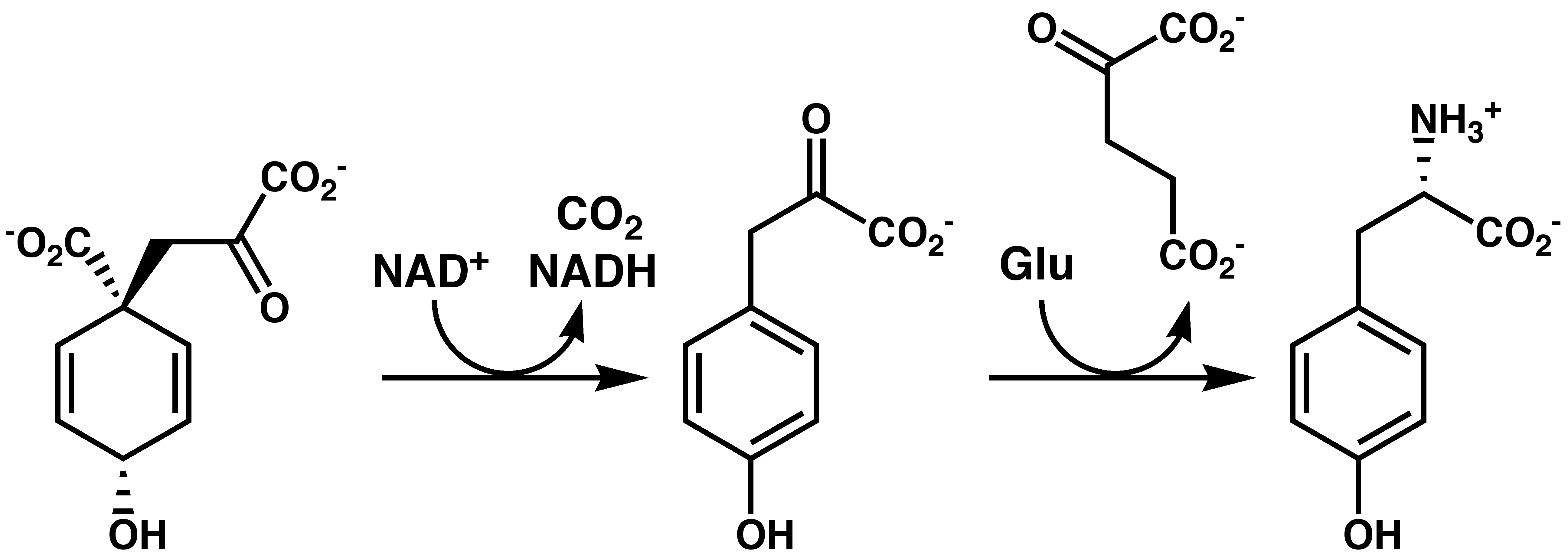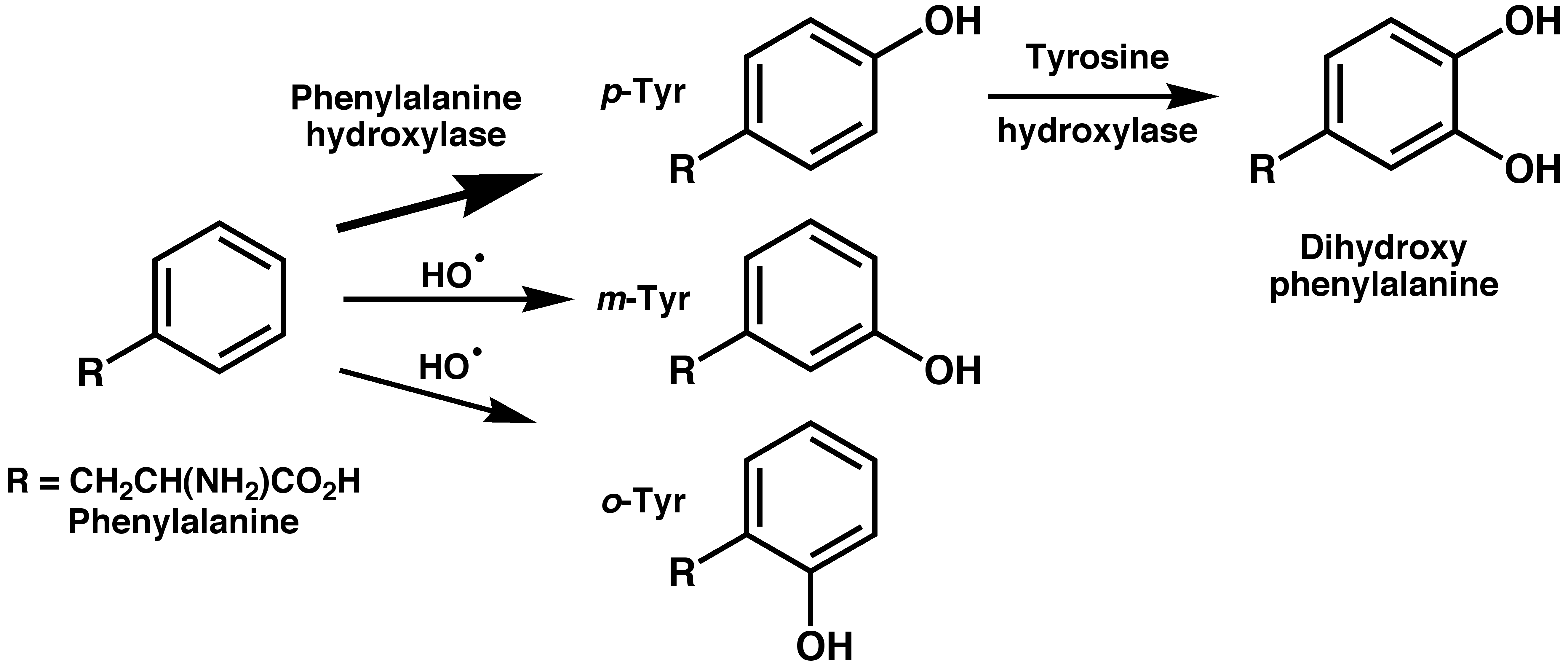Tyrosine
Template:NatOrganicBox Editor-In-Chief: C. Michael Gibson, M.S., M.D. [1]
Overview
Tyrosine (abbreviated as Tyr or Y)[1] or 4-hydroxyphenylalanine, is one of the 20 amino acids that are used by cells to synthesize proteins. This is a non-essential amino acid and it is found in large quantities in casein. In fact, the word "tyrosine" is from the Greek tyros, meaning cheese, as it was first discovered in 1846 by German chemist Justus von Liebig in the protein casein from cheese.[2][3]
Functions
Aside from being a proteogenic amino acid, tyrosine has a special role by virtue of the phenol functionality. It occurs in proteins that are part of signal transduction processes. It functions as a receiver of phosphate groups that are transferred by way of protein kinases (so-called receptor tyrosine kinases). Phosphorylation of the hydroxyl group changes the activity of the target protein.
A tyrosine residue also plays an important role in photosynthesis. In chloroplasts (photosystem II), it acts as an electron donor in the reduction of oxidized chlorophyll. In this process, it undergoes deprotonation of its phenolic OH-group. This radical is subsequently reduced in the photosystem II by the four core manganese cluster.
Biosynthesis

In plants and most microorganisms, tyr is produced via prephenate, an intermediate on the shikimate pathway. Prephenate is oxidatively decarboxylated with retention of the hydroxyl group to give p-hydroxyphenylpyruvate, which is transaminated using glutamate as the nitrogen source to give tyrosine and α-ketoglutarate.
Mammals synthesize tyrosine from the essential amino acid phenylalanine (phe), which is derived from food. The conversion of phe to tyr is catalyzed by the enzyme phenylalanine hydroxylase, a monooxygenase. This enzyme catalyzes the reaction causing the addition of an hydroxyl group to the end of the 6-carbon aromatic ring of phenylalanine, such that it becomes tyrosine.
Metabolism

Phosphorylation and sulfation
Some of the tyrosine residues can be tagged with a phosphate group (phosphorylated) by protein kinases. (In its phosphorylated state, it is referred to as phosphotyrosine). Tyrosine phosphorylation is considered to be one of the key steps in signal transduction and regulation of enzymatic activity. Phosphotyrosine can be detected through specific antibodies. Tyrosine residues may also be modified by the addition of a sulfate group, a process known as tyrosine sulfation.[4] Tyrosine sulfation is catalyzed by tyrosylprotein sulfotransferase (TPST). Like the phosphotyrosine antibodies mentioned above, antibodies have recently been described that specifically detect sulfotyrosine.
Precursor to hormones
In the adrenal gland, tyrosine is converted to levodopa by the enzyme tyrosine hydroxylase (TH). TH is also the rate-limiting enzyme involved in the synthesis of the catecholamine hormones dopamine, norepinephrine (noradrenaline), and epinephrine.
The thyroid hormones triiodothyronine (T3) and thyroxine (T4) in the colloid of the thyroid also are derived from tyrosine.
Precursor to alkaloids
In Papaver somniferum, the opium poppy, tyrosine is used to produce the alkaloid morphine.
Precursor to pigments
Tyrosine is also the precursor to the pigment melanin.
Degradation

The decomposition of L-tyrosine (syn. para-hydroxyphenylalanine) begins with an α-ketoglutarate dependent transamination through the tyrosine transaminase to para-hydroxyphenylpyruvate. The positional description para, abbreviated p, mean that the hydroxyl group and side chain on the phenyl ring are across from each other (see the illustration below).
The next oxidation step catalyzes by p-hydroxylphenylpyruvate-dioxygenase and splitting off CO2 homogentisate (2,5-dihydroxyphenyl-1-acetate). In order to split the aromatic ring of homogentisate, a further dioxygenase, homogentistate-oxygenase is required. Thereby, through the incorporation of a further O2 molecule, maleylacetoacetate is created.
Fumarylacetate is created maleylacetoacetate-cis-trans-isomerase through rotation of the carboxyl group created from the hydroxyl group via oxidation. This cis-trans-isomerase contains glutathione as a coenzyme. Fumarylacetoacetate is finally split via fumarylacetoacetate-hydrolase through the addition of a water molecule.
Thereby fumarate (also a metabolite of the citric acid cycle) and acetoacetate (3-ketobutyroate) are liberated. Acetoacetate is a ketone body, which is activated with succinyl-CoA, and thereafter it can be converted into acetyl-CoA which in turn can be oxidized by the citric acid cycle or be used for fatty acid synthesis.
Ortho- and meta-tyrosine

Three isomers of tyrosine are known. In addition to common amino acid L-tyrosine which is the para isomer (para-tyr, p-tyr or 4-hydroxyphenylalanine) there are two additional regioisomers, namely meta-tyrosine (m-tyr or 3-hydroxyphenylalanine or L-m-tyrosine) and ortho-tyrosine (o-tyr or 2-hydroxyphenylalanine) which occur in nature. The m-tyr and o-tyr isomers, which are rare, arise through non-enzymatic free-radical hydroxylation of phenylalanine under conditions of oxidative stress.[5][6]
m-Tyrosine and analogues (rare in nature and therefore available synthetically) have shown application in Parkinson's Disease, Alzheimer's disease and arthritis [7].
Medical use
Tyrosine is a starting material for neurotransmitters and increases plasma neurotransmitter levels (particularly dopamine and norepinephrine)[8] but has little if any effect on mood.[9][10][11] The effect on mood is more noticeable in humans subjected to stressful conditions (see below).
A number of studies have found tyrosine to be useful during conditions of stress, cold, fatigue,[12] prolonged work and sleep deprivation,[13][14] with reductions in stress hormone levels,[15] reductions in stress-induced weight loss seen in animal trials,[12] improvements in cognitive and physical performance[10][16][17] seen in human trials.
Tyrosine does not seem to have any significant effect on mood, cognitive or physical performance in normal circumstances.[18][19][20]
A daily dosage supported in the literature is about 100 mg/kg for an adult. The usual dosage amounts to 500-1500 mg per day (dose suggested by most manufacturers; usually an equivalent to 1-3 capsules of pure tyrosine). It is not recommended to exceed 12000 mg (12 g) per day. In fact, too high doses result in reduced levels of dopamine.[18]
See also
- Tyramine
- Alkaptonuria
- Tyrosinemia
- Albinism
- Tyrosine sulfation
- Betalain
- Iodinated tyrosine derivatives
References
- ↑ IUPAC-IUBMB Joint Commission on Biochemical Nomenclature (1983). "Nomenclature and Symbolism for Amino Acids and Peptides". Recommendations on Organic & Biochemical Nomenclature, Symbols & Terminology. Retrieved 2007-05-17.
- ↑ Tyrosine at infoplease.com
- ↑ Tyrosine at etymonline.com
- ↑ Hoffhines AJ, Damoc E, Bridges KG, Leary JA, Moore KL (2006). "Detection and purification of tyrosine-sulfated proteins using a novel anti-sulfotyrosine monoclonal antibody". J. Biol. Chem. 281 (49): 37877–87. doi:10.1074/jbc.M609398200. PMID 17046811.
- ↑ Molnár GA, Wagner Z, Markó L, Kó Szegi T, Mohás M, Kocsis B, Matus Z, Wagner L, Tamaskó M, Mazák I, Laczy B, Nagy J, Wittmann I (2005). "Urinary ortho-tyrosine excretion in diabetes mellitus and renal failure: evidence for hydroxyl radical production". Kidney Int. 68 (5): 2281–7. doi:10.1111/j.1523-1755.2005.00687.x. PMID 16221230.
- ↑ Molnár GA, Nemes V, Biró Z, Ludány A, Wagner Z, Wittmann I (2005). "Accumulation of the hydroxyl free radical markers meta-, ortho-tyrosine and DOPA in cataractous lenses is accompanied by a lower protein and phenylalanine content of the water-soluble phase". Free Radic. Res. 39 (12): 1359–66. doi:10.1080/10715760500307107. PMID 16298866.
- ↑ Optimized Synthesis of L-m-Tyrosine Suitable for Chemical Scale-Up Cara E. Humphrey, Markus Furegati, Kurt Laumen, Luigi La Vecchia, Thomas Leutert, J. Constanze D. Müller-Hartwieg, and Markus Vögtle Organic Process Research & Development 2007, 11, 1069–1075 doi:10.1021/op700093y
- ↑ Rasmussen DD, Ishizuka B, Quigley ME, Yen SS (1983). "Effects of tyrosine and tryptophan ingestion on plasma catecholamine and 3,4-dihydroxyphenylacetic acid concentrations". J. Clin. Endocrinol. Metab. 57 (4): 760–3. PMID 6885965.
- ↑ Leathwood PD, Pollet P (1982). "Diet-induced mood changes in normal populations". Journal of psychiatric research. 17 (2): 147–54. PMID 6764931.
- ↑ 10.0 10.1 Deijen JB, Orlebeke JF (1994). "Effect of tyrosine on cognitive function and blood pressure under stress". Brain Res. Bull. 33 (3): 319–23. PMID 8293316.
- ↑ Lieberman HR, Corkin S, Spring BJ, Wurtman RJ, Growdon JH (1985). "The effects of dietary neurotransmitter precursors on human behavior". Am J Clin Nutr. 42 (2): 366–370. PMID 4025206.
- ↑ 12.0 12.1 Hao S, Avraham Y, Bonne O, Berry EM (2001). "Separation-induced body weight loss, impairment in alternation behavior, and autonomic tone: effects of tyrosine". Pharmacol. Biochem. Behav. 68 (2): 273–81. doi:10.1016/S0091-3057(00)00448-2. PMID 11267632.
- ↑ Magill RA, Waters WF, Bray GA, Volaufova J, Smith SR, Lieberman HR, McNevin N, Ryan DH (2003). "Effects of tyrosine, phentermine, caffeine D-amphetamine, and placebo on cognitive and motor performance deficits during sleep deprivation". Nutritional Neuroscience. 6 (4): 237–46. PMID 12887140.
- ↑ Neri DF, Wiegmann D, Stanny RR, Shappell SA, McCardie A, McKay DL (1995). "The effects of tyrosine on cognitive performance during extended wakefulness". Aviation, space, and environmental medicine. 66 (4): 313–9. PMID 7794222.
- ↑ Reinstein DK, Lehnert H, Wurtman RJ (1985). "Dietary tyrosine suppresses the rise in plasma corticosterone following acute stress in rats". Life Sci. 37 (23): 2157–63. PMID 4068899.
- ↑ Deijen JB, Wientjes CJ, Vullinghs HF, Cloin PA, Langefeld JJ (1999). "Tyrosine improves cognitive performance and reduces blood pressure in cadets after one week of a combat training course". Brain Res. Bull. 48 (2): 203–9. PMID 10230711.
- ↑ Mahoney CR, Castellani J, Kramer FM, Young A, Lieberman HR (2007). "Tyrosine supplementation mitigates working memory decrements during cold exposure". Physiology and Behavior. IN PRESS. doi:10.1016/j.physbeh.2007.05.003. PMID 17585971.
- ↑ 18.0 18.1 Chinevere TD, Sawyer RD, Creer AR, Conlee RK, Parcell AC (2002). "Effects of L-tyrosine and carbohydrate ingestion on endurance exercise performance". J. Appl. Physiol. 93 (5): 1590–7. doi:10.1152/japplphysiol.00625.2001. PMID 12381742.
- ↑ Strüder HK, Hollmann W, Platen P, Donike M, Gotzmann A, Weber K (1998). "Influence of paroxetine, branched-chain amino acids and tyrosine on neuroendocrine system responses and fatigue in humans". Horm. Metab. Res. 30 (4): 188–94. PMID 9623632.
- ↑ Thomas JR, Lockwood PA, Singh A, Deuster PA (1999). "Tyrosine improves working memory in a multitasking environment". Pharmacol. Biochem. Behav. 64 (3): 495–500. PMID 10548261.
External links
- Tyrosine metabolism
- Phenylalanine and tyrosine biosynthesis
- Phenylalanine, Tyrosine, and tryptophan biosynthesis
- Computational Chemistry Wiki
| Alanine (dp) | Arginine (dp) | Asparagine (dp) | Aspartic acid (dp) | Cysteine (dp) | Glutamic acid (dp) | Glutamine (dp) | Glycine (dp) | Histidine (dp) | Isoleucine (dp) | Leucine (dp) | Lysine (dp) | Methionine (dp) | Phenylalanine (dp) | Proline (dp) | Serine (dp) | Threonine (dp) | Tryptophan (dp) | Tyrosine (dp) | Valine (dp) |
ar:تيروزين ca:Tirosina da:Tyrosin de:Tyrosin eo:Tirozino ko:티로신 id:Tirosin it:Tirosina he:טירוזין lv:Tirozīns lb:Tyrosin lt:Tirozinas nl:Tyrosine su:Tirosin fi:Tyrosiini sv:Tyrosin uk:Тирозин